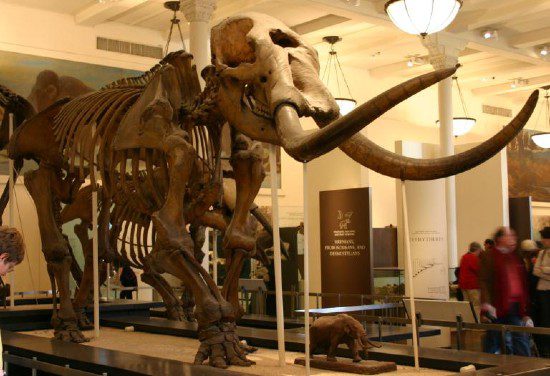From November 27, 2013, “Their Old Kentucky Home: Ken Ham, Al Mohler and Big Bone Lick”
Ken Ham is not treated as a respected scholar by “mainstream” evangelicals. He’s viewed as a fringe character who’s mainly interested in selling a product.
Al Mohler, on the other hand, is regarded as a respected academic and scholar — a seminary president! — and someone that serious people must regard with seriousness.
The two men live and work about 100 miles apart in Kentucky, but when it comes to young-Earth creationism, there’s no space between them at all. It’s odd that science-aversion, reality-denial and wacky exegesis makes Ken Ham a comic figure, while the very same science-aversion, reality-denial and wacky exegesis is hailed as evidence of Al Mohler’s pious devotion to the “authority of the scriptures.”
Young-Earth creationism isn’t plausible anywhere, but it’s a particularly hard sell where these guys live. Kentucky isn’t just home to the Creation Museum and to the Mohlerized Southern Baptist Theological Seminary, it’s also home to places like Big Bone Lick State Park, sometimes called the birthplace of American paleontology. That where we found things like this:

Big Bone Lick — just 82 miles from Al Mohler’s office and less than 20 miles from Ken Ham’s museum — is the final resting place of an extraordinary number of well-preserved Pleistocene megafauna. These were the huge animals that lumbered across North America from about 2.5 million years ago until the last of them went extinct about 12,000 years ago. Mastodons, mammoths and giant sloths lived in Kentucky for millions of years, then died out thousands of years before young-Earth creationists say the universe was created.
Kentucky’s official state fossil — that’s a thing, apparently — is the brachiopod. Those are tiny little sea creatures whose fossil remains can be found all over Kentucky because way, way back — 550 to 250 million years ago — what’s now Kentucky was the bottom of a warm, shallow sea something like the Gulf of Mexico. That also explains why miner Jay Wright found the ferocious jawbone of a prehistoric shark in the ceiling of a Kentucky coal mine. It’s about 300 million years old. That means it was swimming around Kentucky about 300 million years prior to when Ken Ham and Al Mohler say God created the heavens and the Earth. (Well, you know, 300 million minus 6,000 years older, but once you get back to 300 million years ago, 6,000 years seems more like a rounding error.)
Kentucky is also home to things like the Kentucky River Palisades — a series of gorges and limestone cliffs lining the river for about 100 miles or so. They’re really something to see, both for their stunning natural beauty and for the way they vividly illustrate Kentucky’s very long and layered geologic history. The clearly visible layers of sedimentary rock are like a giant billboard advertising how vastly ancient the region truly is.
All of these things account for the difference in reputation between Ken Ham and Al Mohler.
Ham is seen as ridiculous because he has, very publicly, attempted to account for all of these things. The megafauna remains in Big Bone Lick, Ken Ham says, were creatures killed in Noah’s flood in 2348 B.C. And what about all those brachiopod fossils that scientists insist are hundreds of millions of years old? Those are all from Noah’s flood in 2348 too, Ham says. And the 300-million-year-old shark remains? Noah’s flood. And the sedimentary layers of the Kentucky River Palisades? Noah’s flood. 2348 B.C.
This is just goofy. Ham’s repeated appeals to the magical effects of Noah’s magical flood are part of why he’s an object of scorn and ridicule. He tries to play the martyr — claiming that his critics are just impious god-haters who don’t believe in the Bible. But the problem with this flood nonsense isn’t primarily that he believes the story of Noah is historical. The problem with Ken Ham’s flood nonsense is that floods do not work this way.
Ham’s attempts to reconcile his theory of a 6,000-year-old universe with the exuberantly ancient world that surrounds him fail utterly. When he clings to those failures, then, he comes across not just as ignorant, but as stubbornly ignorant and proud of it. That makes him a punchline.
Mohler has avoided becoming a similar punchline by expediently not attempting to reconcile his theory of a 6,000-year-old universe with the obviously ancient world that surrounds him. That seems unfair — unfair to Ken Ham, I mean.
Sure, Ham may be a spectacular failure at it, but unlike Mohler, he’s at least tried to defend their indefensible theory of a young universe. Mohler doesn’t even bother trying. He just keeps repeating his insistence that you’re in jeopardy of Hell if you don’t reject reality in favor of demonstrably false ideas.
If the Earth is only 6,000 years old, then how does Mohler explain the far older remains found 80 miles from his office at Big Bone Lick? That’s simple, Mohler says. If you don’t believe the Earth is only 6,000 years old, then you don’t really believe in the Bible or in the God of the Bible, and therefore you’re probably going to Hell. But those bones are from the Pleistocene, which ended long before 6,000 years ago — is Mohler suggesting that we just pretend those bones and all the other evidence for the Pleistocene don’t exist? No, he says. He’s simply suggesting that Heaven is far nicer than Hell, so let’s just please stop talking about those old bones.
But what about the brachiopod fossils scattered all over Mohler’s home state of Kentucky? We have to choose, he says. We have to choose between learning anything about those fossils and not going to Hell. What about the ancient history written into the very rocks of the Kentucky River Palisades? The rocks are lying. Don’t listen to them or else, you know … Hell.
Where Ken Ham offers ridiculous evidence and a ridiculous argument, Mohler doesn’t bother offering any evidence or argument at all. But I’m not sure how that makes him any less ridiculous.












